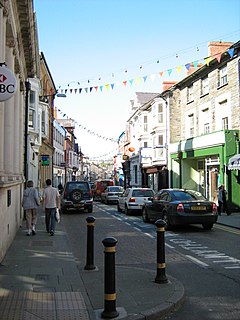
Ceredigion is a principal area of Wales, corresponding to the historic county of Cardiganshire. During the second half of the first millennium Ceredigion was a minor kingdom. It has been administered as a county since 1282. Welsh is spoken by more than half the population. Ceredigion is considered to be a centre of Welsh culture. The county is mainly rural with over 50 miles (80 km) of coastline and a mountainous hinterland. The numerous sandy beaches and the long-distance Ceredigion Coast Path provide excellent views of Cardigan Bay.

Cardigan is a town and community in the county of Ceredigion in Wales. The town lies on a tidal reach of the River Teifi at the point where Ceredigion, formerly Cardiganshire, meets Pembrokeshire. Cardigan was the county town of the historic county and is the second-largest town in Ceredigion. The largest town, Aberystwyth, is one of the two administrative centres; the other being Aberaeron.

Cardigan Island is a small, uninhabited island lying north of Cardigan, in Ceredigion, south-west Wales. It reaches a height of 52 metres (171 ft) a.s.l., and 38 acres (15 ha) in area.

Cardigan Bay is a large inlet of the Irish Sea, indenting the west coast of Wales between Bardsey Island, Gwynedd in the north, and Strumble Head, Pembrokeshire at its southern end. It is the largest bay in Wales.

The National Eisteddfod of Wales is the most important of several eisteddfodau that are held annually, mostly in Wales. Its eight days of competitions and performances are considered the largest music and poetry festival in Europe. Competitors typically number 6,000 or more, and overall attendance generally exceeds 150,000 visitors. The 2018 Eisteddfod was held in Cardiff Bay with a fence-free 'Maes'.

Ceibwr Bay is a bay opening into the Irish Sea in Pembrokeshire, west Wales. It is about 7 km west of Cardigan, and 3 km south of the headland of Cemaes Head. It is owned by the National Trust, within the Pembrokeshire Coast National Park and on the Pembrokeshire Coast Path.

The FAW Welsh Trophy is a knock-out football competition contested annually by teams from Wales and the borders.

The Wales Coast Path is 870 miles (1,400 km) long. The footpath opened on 5 May 2012 and follows, or runs close to, the coastline of Wales. It offers a walking route from Chepstow in the south to Queensferry, Flintshire, in the north.
The Barmouth Junction and Arthog Tramway operated a 3 ft narrow gauge tramway service in Arthog between 1899 and 1903.
The Bells of Aberdovey is a popular song which refers to the village now usually known by its Welsh name of Aberdyfi in Gwynedd, Wales, at the mouth of the River Dyfi on Cardigan Bay. The song is based on the legend of Cantre'r Gwaelod, which is also called Cantref Gwaelod or Cantref y Gwaelod. This ancient sunken kingdom is said to have occupied a tract of fertile land lying between Ramsey Island and Bardsey Island in what is now Cardigan Bay to the west of Wales. The legend supposes that the bells of the submerged lost kingdom can be heard ringing below the waves on the beach at Aberdyfi.

The Cardigan Observer, is a Weekly newspaper published mainly in English. It was circulated generally in the towns and villages of Cardiganshire, Carmarthenshire and Pembrokeshire.
The 1898–99 Welsh Amateur Cup was the ninth season of the Welsh Amateur Cup. The cup was won by Oswestry United Reserves who defeated Shrewsbury based team Singleton & Coles 1-0 in the final, at Welshpool.
The 1907–08 Welsh Amateur Cup was the eighteenth season of the Welsh Amateur Cup. The cup was won by Esclusham White Stars who defeated Brymbo Victoria 1-0 in the final, at Wrexham.
The 1908–09 Welsh Amateur Cup was the nineteenth season of the Welsh Amateur Cup. The cup was won by Carnarvon United who defeated Oak Alyn Rovers 5-1 in the final at Colwyn Bay.
The 1905–06 Welsh Amateur Cup was the sixteenth season of the Welsh Amateur Cup. The cup was won by Buckley Engineers who defeated Porthmadog 3-1 in a replayed final, at Welshpool.
The 1906–07 Welsh Amateur Cup was the seventeenth season of the Welsh Amateur Cup. The cup was won by Buckley Engineers who defeated Aberystwyth 2-1 in a replayed final at Newtown.
The 1919–20 Welsh Amateur Cup was the 25th season of the Welsh Amateur Cup. This was the first time the Competition had been played, following a five-year gap due to World War I. The cup was won by Caerau who defeated Barmouth Comrades 4-1 in the final to become the second team from South Wales to win the Cup.
Llandudno Swifts were a football club from Llandudno who existed during the late Victorian era. The club were first mentioned in 1889. They competed in the Combination, North Wales Coast League, Welsh Cup, FA Cup and North Wales Coast Cup. The club was wound up in 1901 after a period of professionalism. Following the demise of Llandudno Swifts, a new team Llandudno Amateurs were formed.
Llandudno Amateurs were a football club from Llandudno who existed during the Edwardian era. The club were first mentioned in 1901 following the demise of Llandudno Swifts. They competed in the North Wales Coast League, Welsh Cup, and North Wales Coast Cup. This incarnation of the club were last mentioned in 1913.










